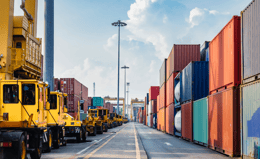Do You Need Transportation Optimization Software?
Brian Hoey - January 28, 2021

 Choosing the right transportation management system (TMS) is a difficult—though necessary—task for any modern supply chain business. Scores of different vendors offer TMS software, all of which are aimed at slightly different use cases and provide varying functionality, which means that businesses have to go into the procurement process with a lot of background knowledge and a clear vision of what they actually need. As a result, the potential is always there for a shipper or carrier to walk away with a solution that isn’t designed to meet their needs.
Choosing the right transportation management system (TMS) is a difficult—though necessary—task for any modern supply chain business. Scores of different vendors offer TMS software, all of which are aimed at slightly different use cases and provide varying functionality, which means that businesses have to go into the procurement process with a lot of background knowledge and a clear vision of what they actually need. As a result, the potential is always there for a shipper or carrier to walk away with a solution that isn’t designed to meet their needs.
As it happens, this problem is common enough that Gartner recently released a guide to handling it (“How to Select the TMS, Provider and Solution Best Suited for Your Strategic Capabilities,” November, 2020). We’re also proud to note that in that guide, they listed flexis as one of their sample vendors under Transportation Optimization Software. But what, exactly, is transportation optimization, and what kinds of businesses and business functions can benefit from implementing it?
Challenges in Finding the Right TMS
In the rundown of various TMS-sourcing challenges that businesses have to grapple with, there were three bullet points that really stood out:
- “As supply chain management applications mature, other factors, such as user experience, ease of implementation or cost of ownership, take on more importance and impact the selection of TMSs.”
- “The TMS market has changed to mainly cloud-based solutions that have adopted emerging technologies to innovate their products further.”
- “As more digital networks and platforms arise in transportation, TMS vendors continue to expand their capabilities and partner networks to mainly focus on visibility and capacity.”
These give a sketch of the problem in a nutshell. Businesses up and down the global value chain are undergoing digital transformations, and they need to identify the right technology from amidst a sea of possible options.
This is difficult for a few reasons. First, technology and partner integration—both of which are crucial factors for defining your IT ecosystem—are always moving targets. In other words, you have to plan for the IT you want and the IT you actually have, which means selecting something that can integrate flexibly as needed. Second, many vendors purport to be everything to every market, which means that someone who primarily needs dispatch management could wind up with a solution designed around freight document management and then spend the rest of the life of the application trying to jury rig it to their specialized use cases. This latter concern is just as much about understanding your own business as it is about understanding a particular piece of technology, but this can be difficult in a less-digitized environment where your planning processes lack transparency and visibility.
What Is Transportation Optimization?
Some of the most common solution types that businesses seek out in the TMS sphere include multimodal domestic or international TMSs, transportation execution systems (TESs), vehicle routing/scheduling solutions, etc. Any of these can be powerful options for mapping out your network and gaining insights into the relevant areas that your transportation and logistics planning flows need to cover. At the same time, each of them can be enhanced and thus made more valuable by the integration of advanced analytics technology with the ability to power digital simulations of your transport flows and help model your ideal transport network.
This is where transportation optimization solutions come in. These solutions can be layered on top of your existing TMS in order to create a more robust, data-driven planning environment. From there, your optimization solution might offer you any of a number of different capabilities:
- Digitally modeling your transportation network for the purpose of increasing visibility—potentially with an eye towards integrating real-time data flows into your planning processes. These real-time flows could, in turn, power faster decision-making in emerging situations, resulting in improved resilience in the face of potential disruptions.
- Utilizing digital models to create potential optimization throughout your transport network. Here, you might use prescriptive analytics trained on data from your network to uncover areas of waste or inefficiency in, say, your arrangement of plants, hubs, docks, and warehouses. This can help you to root out network elements that cost money without meaningfully improving resilience or performance.
- Implementing collaborative planning and decision-making processes based on highly-visible shared network data in a digital environment. This can help create alignment as your team considers hypothetical adjustments to capacities, frequencies, modes, etc. with an eye towards data-driven optimizations.
In this way, you can begin to get more value out of your base TMS software. You can create digital visibility that enables you to start combining strategic, tactical, and operational planning into one cohesive, interconnected process, bringing closer to a network that operates in a lean, data-driven way that cuts out waste (i.e. unnecessary costs) without increasing risk. For simple networks and supply chains, this might be overkill—but for businesses with complex transport networks it can be an absolute necessity.
How to Choose the Right Vendor
Okay, we’ve seen the ways in which transportation optimization solutions can help you get the most value out of the rest of your transportation-related IT infrastructure—but how do you go about selecting the right vendor? After all, given how difficult choosing the right TMS can be, you might think that a series of equally thorny problems would apply to this type of technology as well. While that can certainly be the case, the fact that you can use transportation optimization modules as add-ons to existing TMS technology does make the decision somewhat more straightforward. For starters, your ideal vendor will offer:
- Easy integration with other technologies and modular integration architectures
- Cloud-based deployment options that can help you maintain flexibility and agility
- A strong track record with AI, machine learning, and other analytics technologies
- Specialization in the supply chain and transportation management space
- Reliable support services as needed
Of course, there are plenty of other criteria that you’ll ultimately use to make your decision, but these guidelines should help get you started. As the global supply chain becomes more volatile and cost pressures on enterprise businesses get more severe, technology like transportation optimization software will become increasingly crucial to success—hopefully these tips for selecting a vendor will keep you ahead of the competition.
LATEST POSTS
- Understand Circular Economy in The Manufacturing Industry
- How Can Industry 4.0 IT Integration Be Achieved Smoothly?
- The Significance of Order Sequencing in Discrete Manufacturing
- How to improve your Supply Chain Management: The Power of Control Towers
- Optimizing Human Resource Scheduling in Manufacturing: A Technological Approach



